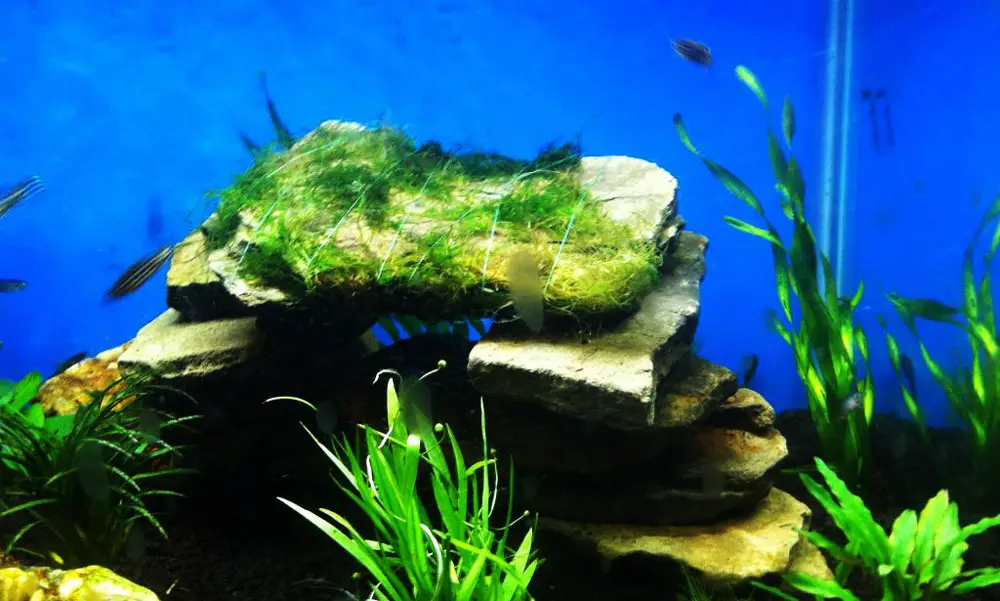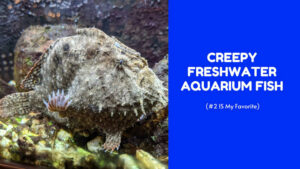The bottom of an aquarium is like a blank canvas, waiting to be filled with the creative expression of its owner. And what better way to personalize your fish tank than by adding your own gravel or stones?
Not only will this give your aquarium a one-of-a-kind look, but it will also provide your fish with a natural and comfortable environment.
As any aquarist knows, slate is a popular choice for lining the bottom of an aquarium. However, the safety of using slate rock in an aquarium is often debated.
So, is slate rock safe for aquariums? In this article, we will explore the pros and cons of using slate in your aquarium so that you can make an informed decision for your fish.
Is Slate Rock Safe for Aquariums?
Slate is a type of metamorphic rock formed from sedimentary rock composed of clay or volcanic ash. It doesn’t have a large amount of calcium, which will not alter the pH and hardness of the aquarium water. Slate is also a very dense rock, which means it won’t break down easily in water.
- Our slate is 100% natural stone that has been sourced, washed, hand picked, and packaged by a family...
- Excellent for aquariums; aquascaping, Iwagumi and nano tanks. The deep grey color is beautiful in a...
- Perfect for reptile enclosures as basking and climbing stones and feeding stations. These stones...
- The color is a beautiful, deep grey matte, with a hint of blue, that is darker when wet. Because this is...
- Thoroughly rinse all stones before placing in your habitat. Absolutely no coatings on this or any of our...
Why Test Slate Rocks?
Be cautious with any slate rocks you put in your aquarium, even if they are sold as “aquarium safe.” To be extra sure, take a close inspection of these rocks before adding them to the tank because:
They Might be Shale
While it seems not to be a prevailing concern anymore, many aquarium experts still caution against using collected outdoor slate rocks because of the possibility of aquarists are confused them with shale.
Being one of the geological ‘soft rocks,’ shale is a sedimentary rock, and it’s soft, crumbly, and has a dusty surface. What’s more, it consists of clay minerals and fragments of other and calcite, which means it will most likely have an impact on water’s pH level and hardness.
They Might Leach Minerals Into Water
Not all natural slates are the same. The newly quarried slate was soaked for several days before being cut into tiles. This way, any minerals leached from the slate will be diluted in water and pose little threat to aquarium inhabitants.
Sometimes, they were just quickly packaged for sale without this treatment. These types of slate might leach minerals into your aquarium water, which can be harmful to fish. You might notice the apparent color changes in the water or fish acting strange if this happens.
On the other hand, some types of slate have been used for centuries as roofing materials or floor tiles. If these slates are not tested before being used in an aquarium, they might leach, too.
Also, don’t use slate with small to medium-sized cavities inside; they are known as vugs that may be filled with calcite and other mineral concentrations. Don’t be fooled by their sparkly gold or silver coloration, as these minerals can be toxic to fish.
They Might Have Sharp Edges
Sharp edges are the most common issue with slate rocks. While the natural slate is safe for aquariums, the sharp edges can hurt fish and other aquarium inhabitants, especially those with delicate long flowing fins, like Angelfish, Bettas, Catfish, and Cichlids. If you do use slate in your aquarium, make sure to smooth out any sharp edges with a rock tumbler or file.
How To Test Slate Rocks for Fish Tank Safety?
As we mentioned earlier, the principal danger of using slate rocks in your home aquarium is the possibility that they might be shale, which contains calcium carbonate (CaCO3) that can affect the pH and hardness of the water in a way to harm your fish.
Before testing, make sure to wash the slate rocks with warm water and scrub them with a stiff brush to remove any dirt, debris, or residue.
The best way to test slate rocks from shale is to drop them in a bucket of vinegar (acetic acid). If the rock foams or fizzes, it contains calcium carbonate and should not be used in your aquarium. If there is no reaction, the slate is safe to use.
Another way of testing slate rocks is to scrape the surface of the slate rock with your fingernail. There should not be any accumulation of rock dust under your nail. If there is, the slate is not safe to use in your aquarium.
The third way of testing slate rocks is to place them in a bucket or container with your aquarium water and make sure they are fully submerged. Test the pH and hardness of the water before and after adding the slate rock. If there is a significant increase in the pH and hardness of the water, the slate rock is not safe to use.
How do I Prepare My Slate Rocks for My Aquarium?
If you’ve followed the steps above and are sure that your slate rocks are safe for your aquarium, the next step is to prepare them.
The preparation contains two parts: cleaning and sterilizing.
How Do You Clean Slate Rocks for Aquariums?
When you’ve tested your slate rocks and are safe to use, you’ll need a thorough clean-up before adding them to your aquarium.
Fortunately, it’s not as difficult as you might think. Just follow these simple steps, and you’ll have clean slate rocks in no time:
- Submerge the slate rocks in hot water and sit for 20-30 minutes until the water cools. This will help to loosen any dirt or debris that might be clinging to the rocks.
- After the time is up, use a stiff brush to scrub the rocks clean. Using soap is unnecessary, but if you feel like you need it, use an aquarium-safe soap, like Softsoap Aquarium Series.
- Once the rocks are clean, check if there are vugs or sharp edges.
- After that, all you need to do is rinse the rocks off with clean water and let them dry completely.
- Now that your slate rocks are clean and ready to go, it’s time to sterilize.
How Do You Sterilize Slate Rocks for Aquariums?
Like anything you add to your aquarium, it’s essential to sterilize slate rocks before adding them to the tank. It will help prevent the spread of disease and protect your fish from potentially harmful bacteria.
There are a few different ways to sterilize slate rocks for aquariums.
Bleach Soaking
The most efficient way to sterilize slate rocks is by soaking them in a bleach solution, which will help oxidize and rapidly break down harmful bacteria or spores that are lingering on the stones.
Here’s a step-by-step guide on how to sterilize slate rocks using bleach:
- Get a large container, and mix 1 part bleach with 9 parts water. Distilled water is better. In this case, use 2 teaspoons of bleach per gallon.
- Fully submerge the slate rocks for 15 minutes.
- After 15 minutes, take the rocks out of the bleach solution and rinse them off with tap water.
- Clean the container you used to bleach the slate rocks and rinse it off with tap water.
- Place the rocks in the clean container and fill it with dechlorinated or distilled water. Let them soak for at least 24 hours. The long soak will help to remove any residual bleach from the rocks.
- After 24 hours, take the slate rocks out of the container and let them dry completely before adding them to your aquarium.
The process seems like a lot, but it’s a popular cleansing method amongst aquarium users. It’s worth the effort to avoid any potential problems down the road.
Boiling
Another well-known but controversial method of sterilizing slate rocks is boiling them, which is the easiest way, but slate tiles can be very delicate, and boiling them can cause them to crack or break.
In addition, rocks can explode when heated, and it’s always best to err on the side of caution and avoid this method if possible.
If you choose to boil your slate rocks, be sure to do so outside in a large pot, not in your kitchen.
Here are the steps:
- Get a pot that’s big enough to fit all of your slate rocks and fill it with water.
- Wait until the water boils.
- Use a pair of kitchen tongs to place the stone in the boiling water for 20-30 seconds.
- Then turn the stone over for another 20-30 seconds.
- Take the slate rocks out of the boiling water and let them cool completely. And that’s it.
The time is the key here, you don’t want to boil the slate rocks for too long, or they will crack.
DIY Aquarium Slate Caves & Structure Ideas
Once you have your slate rocks cleaned and sterilized, it’s time to get creative.
Aquarium slate rock is ideal for aquascaping and can be used to create caves, cliffs, and hiding spots for fish. They are the best places to collect algae and anchor live plants. You can also use them to build structures like bridges or archways.
The possibilities are endless, and the only limit is your imagination.
Here are a few ideas to get you started:
DIY Aquarium Slate Structure
A DIY aquarium slate structure can be a great addition to your fish tank. Not only will it provide a place for your fish to hide and explore, but it can also be a beautiful addition to your aquascape.
Building a DIY slate cave is a relatively straightforward process, and all you need is some aquarium-safe silicone and slate rocks. Start by gluing the slate rocks together to create the basic shape of your cave. Then, let the silicone dry completely before adding it to your aquarium.
DIY Aquarium Slate Caves
Aquarium caves are a must-have for many freshwater species, especially for a breeding cichlid tank. Caves provide a safe place for fish to hide and lay their eggs.
Natural slate tiles can be layered and glued together to create beautiful and functional aquarium caves, ledges, and crevices that your fish can use for shelter and spawning.
Anchor Aquarium Plants

Slate comes with a wide range of coloration, including some beautiful shades of green and solid black. When submerged in aquarium water, the stones tend to darken, creating a sleek black color.
This can be used to your advantage when aquascaping by using the slate rocks to anchor live plants in your aquarium. The darker color of the slate will make the plants stand out and add contrast to your aquascape.
FAQs:
Where to Buy Slate for Aquarium?
You can find slate rocks at your local pet store or Amazon. Be sure to check that the slate is aquarium-safe and doesn’t contain any harmful chemicals.
Can You Put Black Slate in a Fish Tank?
Yes, black slate is safe for fish tanks as long as it is aquarium-safe and doesn’t contain any harmful chemicals.
Can Slate Kill Fish?
No, slate won’t kill fish unless it contains harmful chemicals. If you’re unsure, it’s always best to test the slatebefore adding it to the tank.
Final Words
Slate rock is a popular choice for many aquarium hobbyists, and it’s easy to see why. The rocks are beautiful, versatile, and relatively easy to clean and sterilize.
If you’re thinking about using slate rock in your aquarium, be sure to follow the steps outlined in this article to avoid any potential problems.
Have you used slate rock in your aquarium? Let us know in the comments below.






